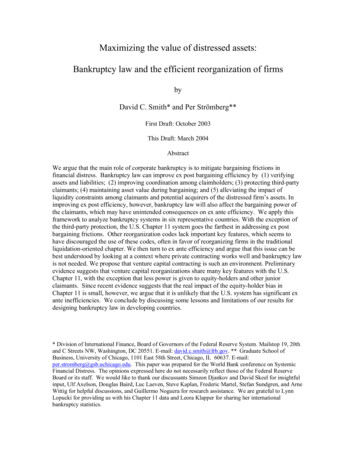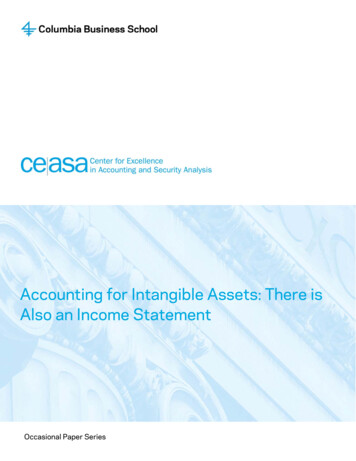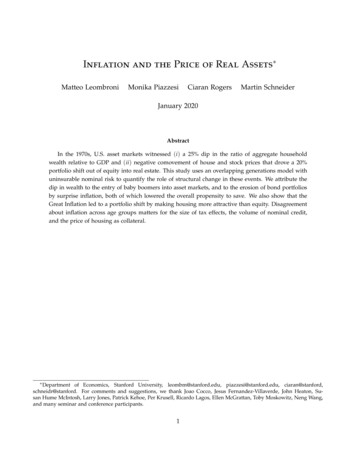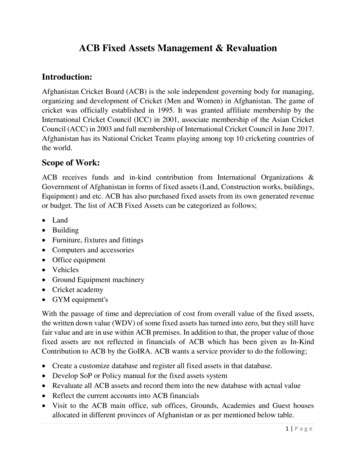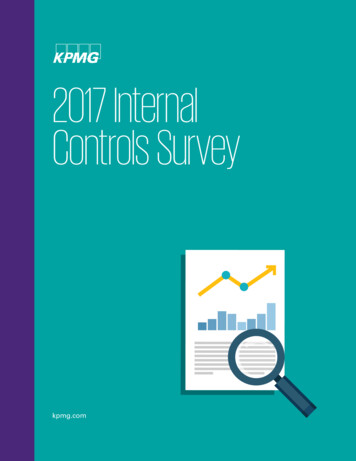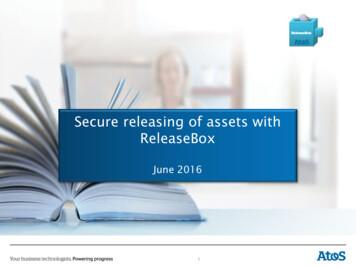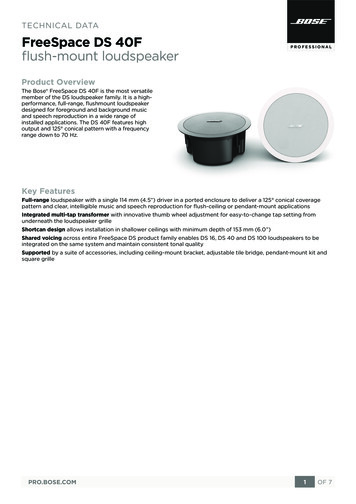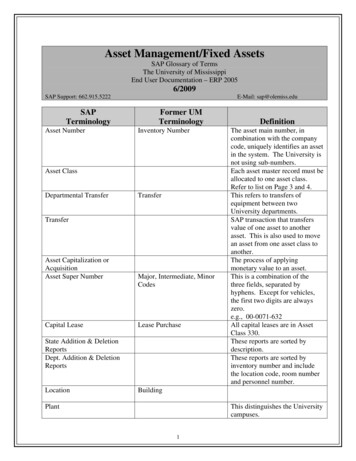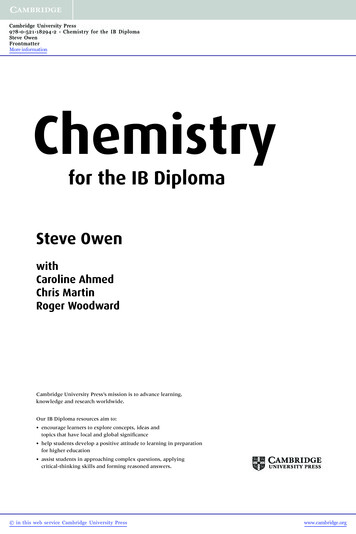
Transcription
Cambridge University Press978-0-521-18294-2 - Chemistry for the IB DiplomaSteve OwenFrontmatterMore information8]Zb hign[dg i]Z 7 9 eadbVHiZkZ DlZcl i]8Vgda cZ 6]bZY8]g h BVgi cGd\Zg LddYlVgYCambridge University Press’s mission is to advance learning,knowledge and research worldwide.Our IB Diploma resources aim to:t FODPVSBHF MFBSOFST UP FYQMPSF DPODFQUT JEFBT BOE topics that have local and global significancet IFMQ TUVEFOUT EFWFMPQ B QPTJUJWF BUUJUVEF UP MFBSOJOH JO QSFQBSBUJPO for higher educationt BTTJTU TUVEFOUT JO BQQSPBDIJOH DPNQMFY RVFTUJPOT BQQMZJOH critical-thinking skills and forming reasoned answers. in this web service Cambridge University Presswww.cambridge.org
Cambridge University Press978-0-521-18294-2 - Chemistry for the IB DiplomaSteve OwenFrontmatterMore informationcam b r i d g e u n i v e r s i ty p r e s sCambridge, New York, Melbourne, Madrid, Cape Town,Singapore, São Paulo, Delhi, Tokyo, Mexico CityCambridge University PressThe Edinburgh Building, Cambridge CB2 8RU, UKwww.cambridge.orgInformation on this title: www.cambridge.org/9780521182942 Cambridge University Press 2011This publication is in copyright. Subject to statutory exceptionand to the provisions of relevant collective licensing agreements,no reproduction of any part may take place without the writtenpermission of Cambridge University Press.First published 2011Printed in India by Replika Press Pvt. LtdA catalogue record for this publication is available from the British LibraryISBN 978-0-521-18294-2 Paperback with CD-ROM for Windows and MacCambridge University Press has no responsibility for the persistence oraccuracy of URLs for external or third-party internet websites referred to inthis publication, and does not guarantee that any content on such websites is,or will remain, accurate or appropriate.This material has been developed independently by the publisher and thecontent is in no way connected with nor endorsed by the InternationalBaccalaureate Organization.The publisher would like to thank the following teachers for reviewingthe content:Aidan Hayes, King’s College School, LondonRonald F. Owens, Kinston High School, North Carolina in this web service Cambridge University Presswww.cambridge.org
Cambridge University Press978-0-521-18294-2 - Chemistry for the IB DiplomaSteve OwenFrontmatterMore information8dciZcih6X cdlaZY\ZbZcihiv cigdYjXi dcv dl id jhZ i] h Wdd v& BdaZh 1.11.21.31.41.51.61.7Relative massesThe mole and Avogadro’s constantEmpirical and molecular formulasChemical equationsCalculations involving moles and massesCalculations involving volumes of gasesCalculations involving solutions' 6idb X higjXijgZ 2.12.22.3 A2.42.5AtomsRelative atomic masses and the massspectrometerElectronic arrangements and atomicemission spectraElectronic configurationsIonisation energy( 7dcY c\ A3.13.23.33.43.53.63.73.83.93.10Ionic bondingCovalent molecular substancesShapes of moleculesHybridisationSigma and pi bondingDelocalisationPolarityIntermolecular forcesGiant covalent substancesMetallic bonding) I]Z eZg dY X iVWaZ 4.14.24.34.411 A251115* 2336546268734.6 AThe periodic tablePhysical propertiesChemical properties of elements ingroup 1 and group 7Properties of the oxides of period3 elementsProperties of the chlorides of period3 elementsThe transition elements143145154156161164:cZg\Zi Xh 1805.15.21805.35.45.55.65.75.854584.5143Exothermic and endothermic reactionsCalculation of enthalpy changes fromexperimental dataHess’s lawBond enthalpiesCalculating enthalpy changesEnthalpy changes for ionic compoundsEntropySpontaneity GViZh d[ gZVXi dc 848490 A100109113115, 119122133137 g the rate of a chemicalreactionCollision theoryThe rate expressionThe Arrhenius equationMechanisms of reactions242246252261264:fj a Wg jb Position of equilibriumThe equilibrium constantCalculations using equilibrium constantsIndustrial processesPhase equilibria in this web service Cambridge University Presswww.cambridge.org
Cambridge University Press978-0-521-18294-2 - Chemistry for the IB DiplomaSteve OwenFrontmatterMore information- 6X Yh VcY WVhZh A8.18.28.38.48.58.68.78.8Reactions of acids and basesDefinitions of acids and basesStrong and weak acids and basespHCalculations involving acids and basesAcid–base titrations and indicatorsSalt hydrolysisBuffer solutions. GZYdm A A9.19.29.39.49.59.69.7Oxidation and reductionRedox equationsReactivity seriesVoltaic cellsStandard electrode potentialsElectrolysis of molten saltsElectrolysis of aqueous solutions&% Dg\Vc X X]Zb hign 10.110.210.310.4Homologous seriesIsomersNaming organic sCompounds containing oxygenHalogenoalkanesCondensation reactionsReaction pathwaysStereoisomerism312313 A316321 A324342&& BZVhjgZbZci VcY 354YViV egdXZhh c\ 35911.1 Uncertainties in measurements11.2 Uncertainties in calculations37511.3 64714824875035035095146eeZcY m/ i]Z eZg dY X iVWaZ 524 adhhVgn 525 cYZm 531IZgbh VcY XdcY i dch d[ jhZ [dg i]Z 53889"GDB 6X cdlaZY\ZbZcihThe author and publishers are grateful for thepermissions granted to reproduce photos.Cover, p. 172 Charles D. Winters/SPL; p. 57t PasqualeSorrentino/SPL; p. 57b Martin Dohrn/SPL; p. 138Photoshot Holdings Ltd/Alamy; p. 160 Tony Craddock/SPL; p. 242t Doug Steley C/Alamy; p. 242b Tom Wood/Alamy; p. 299 Emilio Segre Visual Archives/AmericanInstitute of Physics/SPL; p. 312 Grant HeilmanPhotography; p. 318t Maximilian Stock Ltd/SPL; p.318b Michael McCoy/SPL; p. 319l Simon Fraser/SPL;p. 319r Mark Leach/Alamy; pp. 320, 436, 443 MartynF. Chillmaid/SPL; p. 406l catnap/Alamy; p. 406r DavidNunuk/SPL; p. 412 Jorgen Udvang/Alamy; p. 432, 442Cordelia Molloy/SPL; p. 445 67photo/Alamy; p. 473Stephen Giardina/Alamy; p. 480t mediacolor’s/Alamy;p. 408b Michael Dwyer/AlamyPhotos on the CD-ROMOption A p. 25l Maura Fermariello/SPL; p. 25r SimonFraser/SPL; p. 30 Martyn F. Chillmaid; Option B p. 44Martin Shields/SPL; Option D p. 22 Bo Veisland MI&I/SPL; Option E p. 18 Robert Brook/SPLSPL Science Photo Libraryt top, b bottom, l left, r right k in this web service Cambridge University Presswww.cambridge.org
Cambridge University Press978-0-521-18294-2 - Chemistry for the IB DiplomaSteve OwenFrontmatterMore information cigdYjXi dcThis book is designed as a complete guide to the IB Chemistry courses at both SL and HL. The book contains allthe material required for the main part of the SL and HL courses and the CD-ROM contains the full text of thebook in PDF format as well as the Options material (required for Paper 3). Also included on the CD-ROM are acomprehensive guide to Internal Assessment (writing up practical work) and a revision checklist.Chemistry is about understanding and not just recalling facts, and the emphasis throughout the book and CDROM is on explaining the concepts involved in the course. At this level Chemistry should make sense and, hopefully,as you work your way through each chapter you will feel confident that you have fully grasped all the material.Each chapter is divided into sections which include assessment statements as starting and reference points. Shortanswer questions appear throughout the text so you can check your progress and make sure that you have fullyunderstood what has been discussed. There are also links to interactive questions on the CD-ROM, which you canuse to further test yourself, as well as animations and simulations that will help you gain a deeper understanding of theconcepts.You can link straight through to these features by clicking on the CD icons in the PDF version of the book.Examination style questions appear at the end of each chapter; these could be used either when you have finishedstudying a chapter or towards the end of the course when you are preparing for the exams. Overall in the book andthe CD-ROM there are well over 1000 questions, so there should be plenty of opportunities to practise all aspects ofthe course. Answers to all questions are given on the CD-ROM. dl id jhZ i] h Wdd Sections that cover material from the Higher Level syllabus only are marked with an ‘HL’ bar: AAs you read this book you will see that certain features are shown in different coloured boxes.At the start of each section you will find a list of learning objectives,AZVgc c\ dW ZXi kZhdetailing what you will be expected to know after studying the section.The learning objectives are derived from the assessment statements inr Understand what is meant bythe syllabus.hybridisationr Predict the hybridisation ofan atom in a moleculeThroughout the text, key fact boxesIons are charged particles,(left) inform you of key definitions andwhich are formed when atomsother facts that you should memorise,lose or gain electrons.while info bars (right) give additionalinformation on various subjects relatedto the text.Theory of Knowledge (TOK) boxes are also found throughout the book.These provide food for thought and support the TOK you willstudying in your IB Diploma programme.Again, a consideration of the formalcharges on each atom would regardthis structure as less likely.text.There are variousbetheories of acidsand bases. We haveencountered the Brønsted–Lowry and Lewis theories. CIGD9J8I DC in this web service Cambridge University Presskwww.cambridge.org
Cambridge University Press978-0-521-18294-2 - Chemistry for the IB DiplomaSteve OwenFrontmatterMore informationAs you read, you will also see ‘test yourself ’ questions at various points in the text, usually at the end of a section.These will allow you to keep a check on your progress as you work through each chapter.IZhi ndjghZa[1 Give the number of protons, neutrons and electronsin the following atoms:238758192 U33As35 Br2 Give the number of protons, neutrons and electronsin the following ions:402 127 1403 20Ca53 I58Ce3 If you consider the most common isotopes ofelements as given in a basic periodic table, howmany elements have more protons than neutrons inan atom?Throughout the text there are boxes that give information about theapplications of chemistry, historical references, internationalism orinteresting facts related to the topic under consideration.The CD symbol indicates extra features that are included on the CDaccompanying this book. These include animations, extra sets of questions,simulations and so forth.It was originally thought thatall acids contain oxygen, andthe names of this element inEnglish, german (Sauerstoff) andseveral other languages reflect thismistaken assumption.HZa["iZhi &k in this web service Cambridge University Presswww.cambridge.org
978-0-521-18294-2 - Chemistry for the IB Diploma Steve Owen Frontmatter More information. k As you read, you will also see ‘test yourself’ questions at various points in the text, usually at the end of a section. These will allow you to keep a check on your progress as you work through each chapter. Throughout the text there are boxes that give information about the applications of .
